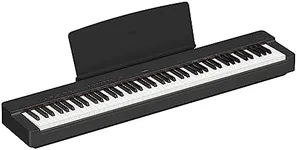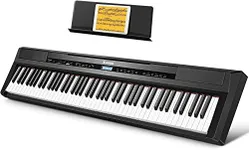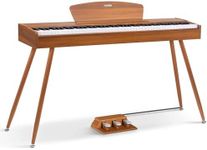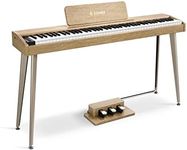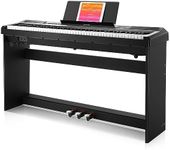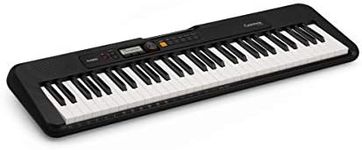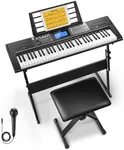Buying Guide for the Best Piano Keyboards
Choosing the right piano keyboard can be a rewarding experience, whether you're a beginner, a hobbyist, or an experienced player. The key is to match the keyboard's features to your musical goals, playing style, and the space you have available. Understanding the main specifications will help you make a confident decision and ensure you get the most enjoyment and value from your instrument.Number of KeysThe number of keys on a keyboard determines the range of notes you can play. Full-size keyboards have 88 keys, just like an acoustic piano, which is ideal for classical music and advanced pieces. Smaller keyboards may have 61 or 76 keys, which are lighter and more portable, and can be suitable for beginners or those focusing on pop and electronic music. If you plan to play complex or classical pieces, go for 88 keys. If portability or space is a concern, or if you're just starting out, a smaller keyboard might be a better fit.
Key Action (Weighted, Semi-Weighted, Synth-Action)Key action refers to how the keys feel when you press them. Weighted keys mimic the feel of an acoustic piano and are best for those who want a realistic piano experience. Semi-weighted keys are lighter but still offer some resistance, making them a good middle ground. Synth-action keys are the lightest and easiest to press, which can be helpful for beginners or for playing fast electronic music. Choose weighted keys if you want to develop proper piano technique, or lighter actions if comfort and ease are more important to you.
Touch SensitivityTouch sensitivity means the keyboard responds to how hard or soft you press the keys, affecting the volume and expression of the sound. This feature is important for expressive playing and learning dynamics. Some keyboards allow you to adjust or turn off touch sensitivity. If you want to play expressively or plan to transition to an acoustic piano, look for a keyboard with touch sensitivity. If you just want to play simple tunes or use the keyboard for basic learning, this may be less critical.
Sound Quality and VoicesSound quality refers to how realistic and pleasing the keyboard's tones are, while 'voices' are the different instrument sounds available (like piano, organ, strings, etc.). Higher-quality keyboards use better sound samples and speakers, making them sound more like real instruments. If you want a more authentic piano sound or plan to perform, prioritize sound quality. If you enjoy experimenting with different sounds, look for a keyboard with a wide variety of voices.
PolyphonyPolyphony is the number of notes a keyboard can play at once. A higher polyphony count allows for more complex music, especially when using sustain pedals or layered sounds. Basic keyboards may have 32 or 64-note polyphony, while more advanced ones offer 128 or more. If you play simple melodies, lower polyphony is fine. For more advanced pieces, layering sounds, or using sustain, higher polyphony is important to avoid notes cutting off.
Portability and SizePortability and size are about how easy it is to move and store the keyboard. Lighter, more compact keyboards are easier to transport and fit into small spaces, making them great for students or those with limited room. Larger, heavier keyboards with stands are better for a permanent setup. Consider where you'll use the keyboard most and whether you'll need to move it often.
Connectivity (MIDI, USB, Audio Outputs)Connectivity options let you connect your keyboard to computers, other instruments, or sound systems. MIDI and USB connections are useful for recording, using music software, or connecting to learning apps. Audio outputs allow you to plug into speakers or amplifiers for performances. If you want to record music, use learning apps, or perform, make sure your keyboard has the right connections. If you'll only play at home for fun, basic connections may be enough.
Built-in Features (Metronome, Recording, Learning Tools)Many keyboards come with built-in features like metronomes, recording functions, and learning tools. These can help you practice timing, record your playing, or learn new songs. If you're a beginner or want to improve your skills, these features can be very helpful. More experienced players may not need as many built-in tools, but they can still be convenient for practice and creativity.

